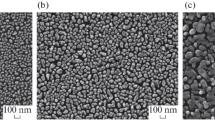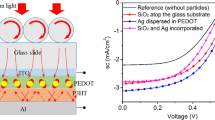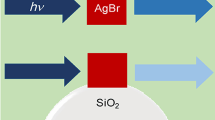Abstract
We experimentally and theoretically characterize back-scattering and extinction of Ag nanoparticle (AgNP) arrays on both Si wafer substrates and optically-thick Ag substrates with and without organic poly(3-hexylthiophene):[6,6]-phenyl C61-butyric acid methyl ester (P3HT:PCBM) bulk-heterojunction thin film coatings. A strong red-shift in back-scattered light wavelength occurs from AgNP arrays on Si as a function of increasing mean nanoparticle diameter (ranging from 30 to 90 nm). Back-scattering from the AgNP array is notably quenched in the wavelength range of strong P3HT absorption when the organic layer is applied. However, back-scattering is enhanced to a degree relative to the uncoated AgNP array on Si at wavelengths greater than the absorption band edge of P3HT. For comparison, the optical properties of AgNPs on an optically-thick Ag substrate are reported with and without P3HT:PCBM thin film coatings. On the reflective Ag substrates, a significant enhancement (by a factor of 7.5) and red-shift of back-scattered light occurred upon coating of the AgNPs with the P3HT:PCBM layer. Additionally, red-edge extinction was enhanced in the P3HT:PCBM layer with the presence of the AgNPs compared to the planar case. Theoretical electromagnetic simulations were carried out to help validate and explain the scattering and extinction changes observed in experiment. Both increasing nanoparticle size and an increasing degree of contact with the Si substrate (i.e., effective index of the nanoparticle environment) are shown to play a role in increasing back- and forward-scattering intensity and wavelength, and in increasing absorption enhancements in both the organic and Si layers. AgNPs placed at the P3HT:PCBM/Si interface give rise to absorption increases in P3HT of up to 18 %, and only enhance Si absorption at wavelengths longer than the absorption band edge of P3HT (by almost 90 % in the 660–1,200 nm wavelength range). These results provide insight into how metal nanoparticles placed near an organic/inorganic interface can be employed for light management in tandem or hybrid organic/inorganic thin-film semiconductor configurations for solar energy harvesting applications or light detection applications.






Similar content being viewed by others
References
Abass A, Shen H, Bienstman P, Maes B (2011) Angle insensitive enhancement of organic solar cells using metallic gratings. J Appl Phys 109:023111
Al-Kaysi RO, Ghaddar TH, Guirado G (2009) Fabrication of one-dimensional organic nanostructures using anodic aluminum oxide templates. J Nanomater 2009:1–14
Atwater HA, Polman A (2010) Plasmonics for improved photovoltaic devices. Nat Mater 9:205–213
Bai W, Gan Q, Song G, Chen L, Kafafi Z, Bartoli F (2010) Broadband short-range surface plasmon structures for absorption enhancement in organic photovoltaics. Opt Express 18:A620–A630
Bohren CF, Huffman DR (2004) Absorption and scattering of light by small particles. Wiley, Weinheim
Bridges CR, Dicarmine PM, Fokina A, Huesmann D, Serefos DS (2013) Synthesis of gold nanotubes with variable wall thicknesses. J Mater Chem A 1:1127–1133
Brown PJ, Thomas DS, Köhler A, Wilson JS, Kim J-S, Ramsdale CM, Sirringhaus H, Friend RH (2003) Effect of interchain interactions on the absorption and emission of poly(3-hexylthiophene). Phys Rev B 67:064203
Catchpole KR, Pillai S (2006) Absorption enhancement due to scattering by dipoles into silicon waveguides. J Appl Phys 100:44504
Catchpole KR, Polman A (2008a) Design principles for particle plasmon enhanced solar cells. Appl Phys Lett 93:191113
Catchpole KR, Polman A (2008b) Plasmonic solar cells. Opt Express 16:21793–21800
Curry A, Nusz G, Chilkoti A, Wax A (2005) Substrate effect on refractive index dependence of plasmon resonance for individual silver nanoparticles observed using darkfield microscopy. Opt Express 13:2668–2677
Evanoff DD Jr, Chumanov G (2004) Size-controlled synthesis of nanoparticles. 2. Measurement of extinction, scattering, and absorption cross sections. J Phys Chem B 108:13957–13962
Ferry VE, Sweatlock LA, Pacifici D, Atwater HA (2008) Plasmonic nanostructure design for efficient light coupling into solar cells. Nano Lett 8:4391–4397
Ferry VE, Vershuuren MA, Li HBT, Schropp REI, Atwater HA, Polman A (2009) Improved red-response in thin film a-Si:H solar cells with soft-imprinted plasmonic back reflectors. Appl Phys Lett 95:183503
Ferry VE, Munday JN, Atwater HA (2010a) Design considerations for plasmonic photovoltaics. Adv Mater 22:4794–4808
Ferry VE, Verschuuren MA, Li HBT, Verhagen E, Walters RJ, Schropp REI, Atwater HA, Polman A (2010b) Light trapping in ultrathin plasmonic solar cells. Opt Express 18:A237–A245
Gan G, Bartoli FJ, Kafafi ZH (2013) Plasmonic-enhanced organic photovoltaics: breaking the 10% efficiency barrier. Adv Mater. doi:10.1002/adma.201203323
Hägglund C, Zäch M, Petersson G, Kasemo B (2008) Electromagnetic coupling of light into a silicon solar cell by nanodisk plasmons. Appl Phys Lett 92:053110
Hill HD, Millstone JE, Banholzer MJ, Mirkin CA (2009) The role radius of curvature plays in thiolated oligonucleotide loading on gold nanoparticles. ACS Nano 3:418–424
Kelly KL, Coronado E, Zhao LL, Schatz GC (2003) The optical properties of metal nanoparticles: the influence of size, shape, and dielectric environment. J Phys Chem B 107:668–677
Kirkengena M, Bergli J, Galperin YM (2007) Direct generation of charge carriers in c-Si solar cells due to embedded nanoparticles. J Appl Phys 102:093713
Konda RB et al (2007) Surface plasmon excitation via Au nanoparticles in n-CdSe/p-Si heterojunction diodes. Appl Phys Lett 91:191111
Liao W-S, Yang T, Castellana ET, Kotaoke S, Cremer PS (2006) A rapid prototyping approach to Ag nanoparticle fabrication in the 10–100 nm range. Adv Mater 18:2240–2243
Link S, El-Sayed MA (1999) Spectral properties and relaxation dynamics of surface plasmon electronic oscillations in gold and silver nanodots and nanorods. J Phys Chem B 103:8410–8426
Maier SA, Atwater HA (2005) Plasmonics: localization and guiding of electromagnetic energy in metal/dielectric structures. J Appl Phys 98:011101
Masuda H, Satoh M (1996) Fabrication of gold nanodot array using anodic porous alumina as an evaporation mask. Jpn J Appl Phys 35:L126–L129
Masuda H, Yamada H, Satoh M, Asoh H, Nakao M, Tamamura T (1997) Highly ordered nanochannel-array architecture in anodic alumina. Appl Phys Lett 71:2770–2772
Mock JJ, Smith DR, Schultz S (2003) Local refractive index dependence of plasmon resonance spectra from individual nanoparticles. Nano Lett 3:485–491
Monestier F, Simon JJ, Torchio P, Escoubas L, Flory F, Bailly S, de Bettignies R, Guillerez S, Defranoux C (2007) Modeling the short-circuit current density of polymer solar cells based on P3HT:PCBM blend. Sol Energy Mater Sol Cells 91:405–410
Myroshnychenko V, Rodríguez-Fernández J, Pastoriza-Santos I, Funston AM, Novo C, Mulvaney P, Liz-Marzán LM, de Abajo FJG (2008) Modelling the optical response of gold nanoparticles. Chem Soc Rev 37:1792–1805
Nah Y-C, Kim S-S, Park J-H, Park H-J, Jo J, Kim D-Y (2007) Enhanced electrochromic absorption in Ag nanoparticle embedded conjugated polymer composite films. Electrochem Commun 9:1542–1546
Nakayama K, Tanabe K, Atwater HA (2008) Plasmonic nanoparticle enhanced light absorption in GaAs solar cells. Appl Phys Lett 93:121904
Nehl CL, Hafner JH (2008) Shape-dependent plasmon resonances of gold nanoparticles. J Mater Chem 18:2415–2419
O’Carroll DM, Collopy AX, Ferry VE, Atwater HA (2010) Surface plasmon assisted absorption in conjugated polymer thin films and devices. In: 25th European Photovoltaic Solar Energy Conference and Exhibition, Valencia, pp 834–837
Palik ED (1985) Handbook of optical constants of solids. Academic Press, Boston
Pillai S, Green MA (2010) Plasmonics for photovoltaic applications. Sol Energy Mater Sol Cells 94:1481–1486
Pillai S, Catchpole KR, Trupke T, Green MA (2007) Surface plasmon enhanced silicon solar cells. J Appl Phys 101:093105
Qiao L, Wang D, Zuo L, Ye Y, Qian J, Chen H, He S (2011) Localized surface plasmon resonance enhanced organic solar cell with gold nanospheres. Appl Energy 88:848–852
Saeta PN, Ferry VE, Pacifici D, Munday JN, Atwater HA (2009) How much can guided modes enhance absorption in thin solar cells? Opt Express 17:20975–20990
Schuller JA, Barnard ES, Cai W, Jun YC, White JS, Brongersma ML (2010) Plasmonics for extreme light concentration and manipulation. Nat Mater 9:193–204
Sefunc MA, Okyay A, Demir HV (2011) Plasmonic backcontact grating for P3HT:PCBM organic solar cells enabling strong optical absorption increased in all polarizations. Opt Express 19:14200–14209
Sönnichsen C, Franzl T, Wilk T, von Plessen G, Feldmann J (2002) Drastic reduction of plasmon damping in gold nanorods. Phys Rev Lett 88:077402
Tvingstedt K, Persson N, Inganas O, Rahachou A, Zozoulenko IV (2007) Surface plasmon increase absorption in polymer photovoltaic cells. Appl Phys Lett 91:113514
Yang M, Li J, Li J, Zhu X (2012) Scattering of light by plasmonic nanoparticles on a silicon substrate. Chem Phys Chem 13:2573–2577
Zhang Z, Shimizu T, Senz S, Gösele U (2009) Ordered high-density Si [100] nanowire arrays epitaxially grown by bottom imprint method. Adv Mater 21:2824–2828
Zhao L, Kelly KL, Schatz GC (2003) The extinction spectra of silver nanoparticle arrays: influence of array structure on plasmon resonance wavelength and width. J Phys Chem B 107:7343–7350
Acknowledgments
The authors gratefully acknowledge support from National Science Foundation Grant No. 0903661 “Nanotechnology for Clean Energy IGERT,” a Corning Inc. graduate fellowship, Rutgers’ Institute for Advanced Materials Devices and Nanotechnology, Rutgers’ Aresty Undergraduate Research Fellowship Program, Rutgers’ Research in Science and Engineering (RiSE) Scholarship Program and a Rutgers' Research Council Grant. The authors thank Binxing Yu, Jesse Kohl, Sarah Goodman, and Manika Jain for useful discussions.
Author information
Authors and Affiliations
Corresponding author
Additional information
Special Issue Editors: Juan Manuel Rojo, Vasileios Koutsos
This article is part of the topical collection on Nanostructured Materials 2012
Coleen T. Nemes and Divya K. Vijapurapu have contributed equally to this study.
Rights and permissions
About this article
Cite this article
Nemes, C.T., Vijapurapu, D.K., Petoukhoff, C.E. et al. Absorption and scattering effects by silver nanoparticles near the interface of organic/inorganic semiconductor tandem films. J Nanopart Res 15, 1801 (2013). https://doi.org/10.1007/s11051-013-1801-4
Received:
Accepted:
Published:
DOI: https://doi.org/10.1007/s11051-013-1801-4




